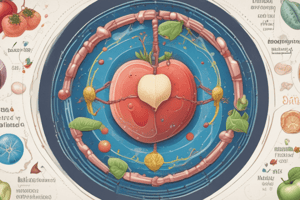Podcast
Questions and Answers
Where does β-oxidation of fatty acids occur?
Where does β-oxidation of fatty acids occur?
- In the mitochondria (correct)
- In the cytosol
- In the nucleus
- In the endoplasmic reticulum
What is the role of carnitine in fatty acid metabolism?
What is the role of carnitine in fatty acid metabolism?
- Facilitates transfer of fatty acids into the mitochondria (correct)
- Stimulates β-oxidation in the endoplasmic reticulum
- Promotes lipogenesis in the cytosol
- Regulates lipid storage in adipose tissue
Which enzyme is responsible for transferring fatty acids to carnitine in the mitochondria?
Which enzyme is responsible for transferring fatty acids to carnitine in the mitochondria?
- Carnitine synthase
- Acyl carnitine transporter
- Carnitine palmitoyl transferase 1 (CPT1) (correct)
- Acyl CoA synthetase
How does the carnitine shuttle operate for transporting long chain fatty acids?
How does the carnitine shuttle operate for transporting long chain fatty acids?
Where do all the synthetic reactions occur in the cell?
Where do all the synthetic reactions occur in the cell?
In which organelle are all the enzymes located?
In which organelle are all the enzymes located?
What is the drug that inhibits HMG-CoA reductase commonly known as?
What is the drug that inhibits HMG-CoA reductase commonly known as?
What is the main function of statins?
What is the main function of statins?
What is the real cause of Sudden Infant Death Syndrome (SIDS)?
What is the real cause of Sudden Infant Death Syndrome (SIDS)?
What is Zellweger syndrome characterized by?
What is Zellweger syndrome characterized by?
What is the primary function of the carnitine shuttle in fatty acid metabolism?
What is the primary function of the carnitine shuttle in fatty acid metabolism?
Which enzyme facilitates the transfer of fatty acids from the cytoplasm to the mitochondria in the carnitine shuttle?
Which enzyme facilitates the transfer of fatty acids from the cytoplasm to the mitochondria in the carnitine shuttle?
Where does β-oxidation of fatty acids primarily occur?
Where does β-oxidation of fatty acids primarily occur?
What is the main product of β-oxidation of a palmitoyl CoA molecule?
What is the main product of β-oxidation of a palmitoyl CoA molecule?
What are ketone bodies synthesized from in the liver during fasting?
What are ketone bodies synthesized from in the liver during fasting?
What condition can result from the accumulation of ketone bodies in the blood and urine due to uncontrolled diabetes mellitus?
What condition can result from the accumulation of ketone bodies in the blood and urine due to uncontrolled diabetes mellitus?
How does the liver regulate the production and use of ketone bodies in normal conditions?
How does the liver regulate the production and use of ketone bodies in normal conditions?
Apart from fatty acids, what other component of triglycerides can be used as an energy source?
Apart from fatty acids, what other component of triglycerides can be used as an energy source?
What are essential fatty acids rapidly converted into?
What are essential fatty acids rapidly converted into?
Where is most cholesterol found in the body?
Where is most cholesterol found in the body?
Study Notes
- The carnitine shuttle is a process that prevents the catabolism of newly synthesized fatty acids after carbohydrate-rich meals, favoring their export from the liver for storage in adipose tissue.
- The shuttling process involves the transfer of fatty acids from the cytoplasm to the mitochondria, which is facilitated by carnitine and the enzyme CPT-1.
- The process of β-oxidation of fatty acids occurs in the mitochondria and consists of four basic reactions: dehydrogenation, hydration, dehydrogenation, and cleavage.
- β-oxidation yields a significant amount of energy, with the oxidation of a palmitoyl CoA molecule producing 131 ATPs.
- Ketone bodies are synthesized by the liver from acetyl CoA derived from fatty acid oxidation. They are important sources of energy for peripheral tissues during fasting.
- Uncontrolled diabetes mellitus can lead to the accumulation of ketone bodies in the blood and urine, resulting in a condition called ketoacidosis, which can cause severe acidosis and other complications.
- In normal conditions, the liver regulates the production and use of ketone bodies to maintain the pH balance in the body.
- Glycerol, a component of triglycerides, can also be used as an energy source via glycolysis and the citric acid cycle.
- Essential fatty acids, such as Arachidonic Acid, are rapidly converted into various bioactive compounds like prostaglandins, prostacyclin, and thromboxane, which control various physiological processes.
- Most cholesterol is in free form and can be absorbed readily from diet, while the body also produces cholesterol endogenously, primarily by the liver and intestinal mucosa.
Studying That Suits You
Use AI to generate personalized quizzes and flashcards to suit your learning preferences.
Related Documents
Description
Test your understanding of lipid metabolism lecture learning objectives. This quiz covers topics such as the role of lipids in metabolism, lipogenesis, and β-oxidation pathways.




